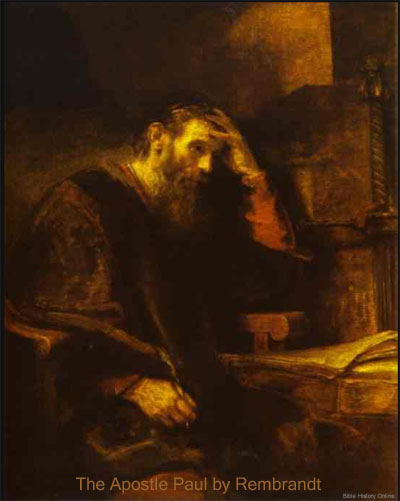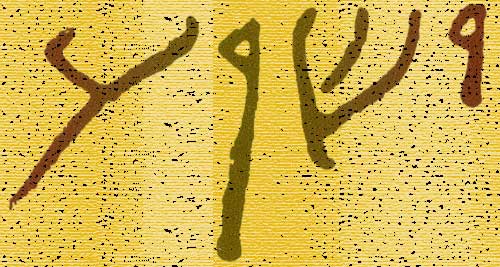12. Greek, "For our wrestling ('the wrestling' in which we are
engaged) is not against flesh," &c. Flesh and blood foes are Satan's
mere tools, the real foe lurking behind them is Satan himself, with whom
our conflict is. "Wrestling" implies that it is a hand-to-hand and
foot-to-foot struggle for the mastery: to wrestle successfully with
Satan, we must wrestle with
GOD in irresistible prayer like Jacob
(Ge 32:24-29;
Ho 12:4).
Translate, "The principalities . . . the
powers"
(Eph 1:21;
Col 1:16;
see on
Eph 3:10).
The same grades of powers are specified in the case of the demons here,
as in that of angels there (compare
Ro 8:38;
1Co 15:24;
Col 2:15).
The Ephesians had practiced sorcery
(Ac 19:19),
so that he appropriately treats of evil spirits in addressing them. The
more clearly any book of Scripture, as this, treats of the economy of
the kingdom of light, the more clearly does it set forth the kingdom of
darkness. Hence, nowhere does the satanic kingdom come more clearly
into view than in the Gospels which treat of Christ, the true Light.
rulers of the darkness of this world--Greek, "age" or "course of
the world." But the oldest manuscripts omit "of world." Translate,
"Against the world rulers of this (present) darkness"
(Eph 2:2; 5:8;
Lu 22:53;
Col 1:13).
On Satan and his demons being "world rulers," compare
Joh 12:31; 14:30; 16:11;
Lu 4:6;
2Co 4:4;
1Jo 5:19,
Greek, "lieth in the wicked one." Though they be "world rulers,"
they are not the ruler of the universe; and their usurped rule of the
world is soon to cease, when He shall "come whose right it is"
(Eze 21:27).
Two cases prove Satan not to be a mere subjective fancy: (1) Christ's
temptation; (2) the entrance of demons into the swine (for these are
incapable of such fancies). Satan tries to parody, or imitate in a
perverted way, God's working
(2Co 11:13, 14).
So when God became incarnate, Satan, by his demons, took forcible
possession of human bodies. Thus the demoniacally possessed were not
peculiarly wicked, but miserable, and so fit subjects for Jesus' pity.
Paul makes no mention of demoniacal possession, so that in the time he
wrote, it seems to have ceased; it probably was restricted to the
period of the Lord's incarnation, and of the foundation of His Church.
spiritual wickedness--rather as Greek, "The
spiritual hosts of wickedness." As three of the clauses describe
the power, so this fourth, the wickedness of our
spiritual foes
(Mt 12:45).
in high places--Greek, "heavenly places": in
Eph 2:2,
"the air," see on
Eph 2:2.
The alteration of expression to "in heavenly places," is in order to
mark the higher range of their powers than ours, they having been, up
to the ascension
(Re 12:5, 9, 10),
dwellers "in the heavenly places"
(Job 1:7),
and being now in the regions of the air which are called the heavens.
Moreover, pride and presumption are the sins in heavenly places
to which they tempt especially, being those by which they themselves
fell from heavenly places
(Isa 14:12-15).
But believers have naught to fear, being "blessed with all spiritual
blessings in the heavenly places"
(Eph 1:3).
JFB.
The Book of Ephesians
Ephesians 2:2-3 - Wherein in time past ye walked according to the course of this world, according to the prince of the power of the air, the spirit that now worketh in the children of disobedience: Among whom also we all had our conversation in times past in the lusts of our flesh, fulfilling the desires of the flesh and of the mind; and were by nature the children of wrath, even as others.
Ephesians 2:8-10 - For by grace are ye saved through faith; and that not of yourselves: it is the gift of God: Not of works, lest any man should boast. For we are his workmanship, created in Christ Jesus unto good works, which God hath before ordained that we should walk in them.
Ephesians 6:11-17 - Put on the whole armour of God, that ye may be able to stand against the wiles of the devil. For we wrestle not against flesh and blood, but against principalities, against powers, against the rulers of the darkness of this world, against spiritual wickedness in high places.
Ephesians in The New Testament - A Brief Overview

Painting of Paul the Apostle by Rembrandt - 1657
Introduction to The Book of Ephesians
Brief Summary. Paul instructs the church that Christianity is for all men, Jews, gentiles, male female, bond, free, all are united in Christ. All men can enter, but it is only by grace, through faith in Christ, and this is God's free gift. The Christian can never revert back to the law of Moses, and to overcome the powers of darkness the believers must unite in Christ.
Summary of The Book of Ephesians
Purpose. While Paul was in prison he had been thinking about his work as an apostle. He realized that Christ came to unite Himself with man, and unity was the core purpose of the book of Ephesians. The Church of Jesus Christ is now the spiritual body of believers who represent Christ on earth. The great truth of Christianity is that God is the uniting the world to Himself through the believers. The idea of unity can be seen clearly in the first chapter of Ephesians ( Ephesians 1:3-10), and this principle of unity is seen throughout the rest of the entire book. God's one eternal purpose is to unite one body of believers through Christ, "the church, which is his body, the fulness of him who filleth all in all" (Ephesians 1:22-23). The Christian is saved by grace, through faith, and the very faith is a gift of God, therefore no one can boast. Christianity is is about God uniting Himself with man, through Jesus Christ, and men being united in Jesus Christ, and this great opportunity is God's gift.
Audience. The book is address by Paul to the church at Ephesus. Most early writers spoke of the epistle as having been addressed to the Ephesians.
Authorship. Paul names himself as the author of the epistle to the Ephesians (Ephesians 1:1 and 3:1). Several of the early church writers site the book of Ephesians, for example Irenaeus and Clement of Alexandria both state that Paul was its author. The style of writing is clearly Paul's, he begins with his customary personal greetings and words of thanks, and addresses issues of doctrine, as with the rest of his letters.
Date. Most scholars agree that Paul wrote his letter to the Ephesians towards the end of his first imprisonment in Rome (Ephesians 3:1; 4:1), which would have been around 61 AD. The letter was hand delivered by Tychicus (Ephesians 6:21) just as the letter to the Colossians had been (Colossians 4:7-9).
Audience. The book is address by Paul to the church at Ephesus. Most early writers spoke of the epistle as having been addressed to the Ephesians.
Outline of the Book of Ephesians
The Believers Position United to God - Chapters 1-3
The Believers Privileges United to One Another - Chapters 4-5
The Believers Protection United Against the Evil One- Chapter 6

The Name Jesus In Ancient Hebrew Text
"Yeshua" in First Century Hebrew Text. This is how the name "Jesus"
would have been written in ancient Hebrew documents. The four letters or
consonants from right to left are Yod, Shin, Vav, Ayin (Y, SH, OO, A).
Jesus is the Greek name for the Hebrew name Joshua or Y'shua which means
"The LORD or Yahweh is Salvation".
Ephesians Maps and Resources
Map of the Roman Empire (14 A.D.) - This map reveals the Roman Empire during the time shortly after the birth of Jesus, in 14 AD at the time of the death of Augustus. The order which prevailed in this extensive empire, the good military roads, and the use of Koine Greek as the general language of culture throughout the area were among the factors which multiplied the rapid spread of the Gospel of Jesus Christ. (Color Map)
Map of Paul's First Missionary Journey (48 A.D.) - This map reveals the areas in Asia Minor where Paul visited in his first missionary journey. Around 48 AD, in the springtime, Paul and his companions Barnabas and Mark were sent on a mission from the church in Antioch. This would be the first of Paul's Missionary Journey's. (Color Map)
Map of Paul's Second Missionary Journey (51 A.D.) - This map reveals the areas in Asia and Greece where Paul visited in his second missionary journey. Paul re-visits a couple cities in Asia, one of which was Lystra where he was stoned and left for dead a few years earlier. He later has a vision that leads him over to Greece and Paul and his companions travel and minister in various cities in Greece (Philippi, Thessalonica, Berea, Athens and Corinth. Later Paul returns to Ephesus and finally to Caesarea and Antioch. (Color Map)
Map of Paul's Third Missionary Journey (54 A.D.) - This map reveals the areas in Asia and Greece where Paul visited in his third missionary journey. On Paul's third missionary journey he returned to the cities he had first visited on his first missionary journey. During this time he decided to remain in Ephesus for about 3 years, and this city was the main focus of his activities and an important Christian community (Acts 19). (Color Map)
Map of the New Testament World - This map reveals the "Nations" within the ancient world during the first century A.D., the time of the New Testament. The map includes the areas of Israel, Asia, Greece, and Italy. (Color Map)
Map of New Testament Asia - This map shows the cities within
Asia Minor during the first century A.D., the time of the New
Testament. The map includes the principal cities of Asia
including Tarsus, Ephesus, and Colossae, and provinces like
Galatia and Pamphilia. (Color Map)